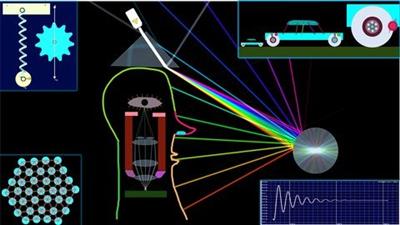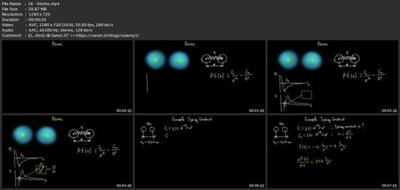O
0

Nanotechnology Part 1: Nanomechanics And Algodoo Simulator
Published 12/2022
MP4 | Video: h264, 1280x720 | Audio: AAC, 44.1 KHz
Language: English | Size: 1.06 GB | Duration: 3h 22m
Understanding nanotechnology using analogies: macroscale physics simulator and nanoscale back-of-envelope calculationss
Published 12/2022
MP4 | Video: h264, 1280x720 | Audio: AAC, 44.1 KHz
Language: English | Size: 1.06 GB | Duration: 3h 22m
Understanding nanotechnology using analogies: macroscale physics simulator and nanoscale back-of-envelope calculationss
What you'll learn
Model mechanical, physical objects and interactions
Compare properties of nanomachines in comparision to macroscopic analogies
Calculation and modelling of particulates in the air
Fluid motion through nano-channel at a very low Reynolds Number
Brownian and mechanical mixer
Atomically Presize Coasting Distance of a Nanocar
Free, damped and forced oscillation: ball-spring system
Nanomechanical mass sensor based on resonant fequency shift
Q factor and beam calculation
Mechano-chemical systems
Atomic bonds, phonons and robots
Requirements
Basic knowledge of Algodoo
Fundamentals of nanotechnology
Description
Human brains create analogies when thinking about the nanoscale. However, human intuition about processes, forces, and interactions in the "nano-world" is often wrong. Nanotechnology is the research and application of materials and devices with dimensions below 100 nm (sometimes larger nanostructures are of interest). Nanotechnology is a highly interdisciplinary science that can be learned from mechanics, photonics, chemistry, physics, biology, materials science, and engineering perspectives. Nanomaterials lead to improvement of myriad of products and discovery of novel quantum, chemical, electrical, optical, and mechanical properties. However, nano- particles, materials, devices, and machines with sizes comparable to atomic clusters are impossible to see with the naked eye and even in optical microscopes. It is challenging to learn nanotechnology because it is complicated to imagine the behaviors of small things in a tiny world. In a simulated "real world", one can build, play, and make own inventions come alive. In Algodoo, one can construct interactive models (by clicking, dragging, tilting, and shaking), explore and play with rigid bodies, fluids, chains, gears, gravity, friction, springs, hinges, etc., in engaging simulated experiments.[Algodoo is a simulator from Algoryx Simulation AB as the successor to the popular program Phun: it simulates mechanical systems based on Newton's laws]. Please note: Algodoo was not created to simulate nanotechnology. The time scale in Algodoo is, by default, 16.666 ms or 1/60 second (60 Hz). For this reason, resolving sub-cm physics in a shorter time-step is challenging. In this course, Algodoo is used to enhance the visualization of processes, devices, and machines (it is assumed that similar or comparable machines exist at the nanoscale). After simulations, back-of-envelope calculations are used to estimate orders of magnitudes and better understand how scaling influences behaviors of nanosystems in comparison to macroscopic analogies.
Overview
Section 1: Introduction
Lecture 1 Introduction
Section 2: Lecture 2
Lecture 2 Information about Algodoo and nanotechnology
Section 3: Examples: Simulations and Nanosystems
Lecture 3 Basic definition
Lecture 4 Algodoo: particulates in the air
Lecture 5 Algodoo: particle sedimentation in the liquid
Lecture 6 Algodoo: fluid motion through nano-channel at a very low Reynolds Number
Lecture 7 Algodoo: Brownian and mechanical mixers
Section 4: Nanomachines
Lecture 8 Nanomachines
Lecture 9 Algodoo: atomically presize coasting distance of a nanocar
Section 5: Free oscillatioins
Lecture 10 Free oscillations: energy and probability
Lecture 11 Free oscillators
Section 6: Dampled oscillations
Lecture 12 Damped oscillations
Section 7: Forced oscillations
Lecture 13 Forced oscillations
Section 8: Nanomechanical mass sensors
Lecture 14 Nanomechanical mass sensor
Lecture 15 Q factor and beam calculation
Section 9: Mechano-chemical systems
Lecture 16 Mechano-chemistry
Section 10: Vibrating atomic bonds
Lecture 17 Schroedinger equation and correspondence principle
Lecture 18 Atoms
Lecture 19 Atomic bonds frequencies
Lecture 20 Quantum mechanics of oscillating atoms
Lecture 21 Algodoo: planetary atom model
Section 11: Phonons
Lecture 22 Phonons: theory
Lecture 23 Phonons in crystal
Lecture 24 Phononic robot
Section 12: Summary
Lecture 25 Nanomechanics summary
Students, engineers and scientists interested to learn more about nanotechnology,This course is for those interested to learn what is the difference between macroscropic and nanoscale analogies

Download link
rapidgator.net:
You must reply in thread to view hidden text.
uploadgig.com:
You must reply in thread to view hidden text.
nitroflare.com:
You must reply in thread to view hidden text.
1dl.net:
You must reply in thread to view hidden text.

